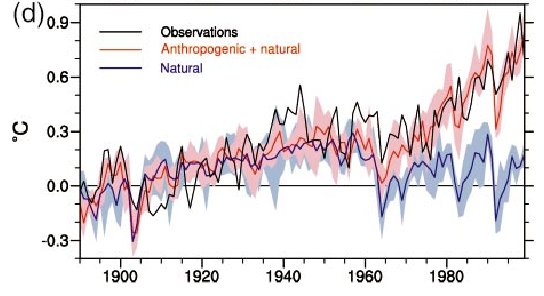Filed Under #climate_change
Aug 18, 2015
Bad for birds, good for squirrels
Here’s a nice video I stumbled upon about Lisa Aubry’s group’s work at Utah State Uni. Climate change is having a positive effect on uinta ground squirrels, allowing them to fatten-up and attain weights higher than those recorded historically. This population is survival limited, and survival probability is higher the fatter the squirrels are, so abundance responds positively to this climate change. I can’t handle how cute those squirrels are 🙂 I wonder what will happen to the rest of the ecosystem as a result of trophic interactions and other effects of increased squirrel abundance? Maybe, if a basic description...Jun 5, 2014
The IPCC First Assessment Report and phenological synchrony
I just found a pretty early reference to the possibility of climate change leading to asynchrony between plant and animal phenology. From Chapter 10 page 295 of Climate Change: The IPCC Scientific Assessment (1990) Of crucial importance in plant community functioning is the synchronous operation of the life cycles of interacting plants, animals and soil organisms. Complex synchronies are found in communities in which the life cycles of plants and pollinating and seed-dispersing animals must be closely linked. Changes in climate could disrupt these synchronies. Unfortunately it didn’t attribute the idea to a reference. I wonder who was the first...May 21, 2014
Are caterpillars really that important?
Typically the the kinds of models that I’m interested in assume that fledging rate is very dependent upon a phenological match between nestlings’ peak food requirements and the peak in caterpillar abundance. However I recently read a study by Cholewa and Wesołowski (2011; Acta Ornithologica) pointing out that, while literature shows that blue tits and marsh tits are indeed strongly dependent upon this food type, other tit species are more versatile and can successfully reproduce without relying upon it. Perhaps more troubling, the authors note that at the time of their writing, there was not a single study available that...Apr 9, 2013
Do birds sometimes respond to warming temperatures by delaying their phenology?
[Update: thoughts in this post contributed to Kristensen et al. (2015), which found mathematical conditions under which phenology may delay.] Climate change has caused an advance in phenological events in many species. In migratory birds, the effects of warming flow causally up the trophic levels. For example, warmer temperatures lead to earlier plant phenology (e.g. budding), which leads to earlier peaks in the abundance of foods (e.g. insect larva) that are important to raising nestlings, which puts pressure upon birds to advance their own breeding timetable. In general, birds have responded to warming weather by advancing their own phenology. Migratory...Mar 13, 2011
Fischer and the CO2 vs temperature lag
One of the most memorable moments in Al Gore’s movie “An Inconvenient Truth” occurs as Gore discusses the ice-core records for CO2 and temperature over the previous 7 “ice-ages”. After graphically showing the strong correlation between CO2 and temperature in these records, Gore is forced to mount a cherry-picker in order to physically point to the height on the graph that CO2 is predicted to reach over the next 50 years. The implication is clear: if CO2 is predicted to get so high, and given that temperature follows CO2, just imagine how high the temperature will be! In several places...Sep 27, 2009
 Roughly speaking, greenhouse gases have been continually increasing since 1900. They underwent a steady increase from 1900, with a sharp acceleration around 1950, followed by continued increase at this faster rate up until now. In contrast, global temperatures have oscillated. They showed a sharp increase from 1920, plateaued and then dropped around 1950, before picking up pace and increasing sharply again around 1970. Recently I was asked by someone, if greenhouse gases drive global temperatures, why haven’t temperatures shown the same pattern of increase as greenhouse gases? The work of Meehl et al. (2004, Journal of Climate), particularly the figures,...
Roughly speaking, greenhouse gases have been continually increasing since 1900. They underwent a steady increase from 1900, with a sharp acceleration around 1950, followed by continued increase at this faster rate up until now. In contrast, global temperatures have oscillated. They showed a sharp increase from 1920, plateaued and then dropped around 1950, before picking up pace and increasing sharply again around 1970. Recently I was asked by someone, if greenhouse gases drive global temperatures, why haven’t temperatures shown the same pattern of increase as greenhouse gases? The work of Meehl et al. (2004, Journal of Climate), particularly the figures,...
Greenhouse gas vs temperature
 Roughly speaking, greenhouse gases have been continually increasing since 1900. They underwent a steady increase from 1900, with a sharp acceleration around 1950, followed by continued increase at this faster rate up until now. In contrast, global temperatures have oscillated. They showed a sharp increase from 1920, plateaued and then dropped around 1950, before picking up pace and increasing sharply again around 1970. Recently I was asked by someone, if greenhouse gases drive global temperatures, why haven’t temperatures shown the same pattern of increase as greenhouse gases? The work of Meehl et al. (2004, Journal of Climate), particularly the figures,...
Roughly speaking, greenhouse gases have been continually increasing since 1900. They underwent a steady increase from 1900, with a sharp acceleration around 1950, followed by continued increase at this faster rate up until now. In contrast, global temperatures have oscillated. They showed a sharp increase from 1920, plateaued and then dropped around 1950, before picking up pace and increasing sharply again around 1970. Recently I was asked by someone, if greenhouse gases drive global temperatures, why haven’t temperatures shown the same pattern of increase as greenhouse gases? The work of Meehl et al. (2004, Journal of Climate), particularly the figures,...